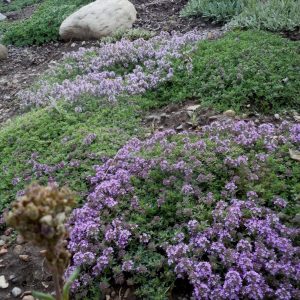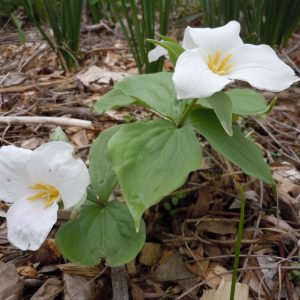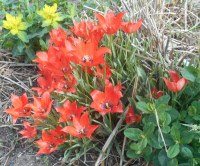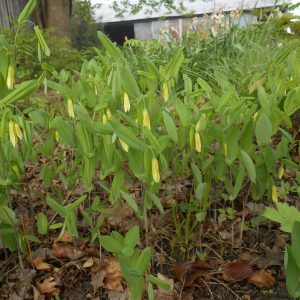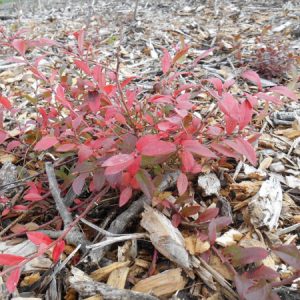Archives
Showing 185–192 of 199 results
-
Thymus serpyllum ssp. arcticus syn. T. praecox Lemon thyme Z 2-9
Purple flowers May – August with evergreen foliage on this tiny leaved plant. Good for groundcover or rock garden.
ARCHIVED
Note: This is a plant not currently for sale. This is an archive page preserved for informational use.
Purple flowers May – June with evergreen foliage on this tiny leaved plant. Good for groundcover or rock garden.
Can not ship to: Maryland
Size: 4” x 12” and spreading
Care: sun to part shade in moist well-drained to well-drained soil
Native: Greenland, Norway, Iceland, the Arctic, much of the US incl WI.This species collected on an expedition in the Arctic before 1855.
-
Trillium grandiflorum Large flowered Trillium, Wake robin Z 4-8
Pure white trio of petals atop whorl of leaves in May. Ephemeral.
ARCHIVED
Note: This is a plant not currently for sale. This is an archive page preserved for informational use.
Pure white trio of petals atop whorl of leaves in May. Ephemeral.
Size: 12-18” x slowly spreading
Care: shade to part shade in moist soil
Native: Quebec to Georgia, west to Minnesota Wisconsin native
Awards: Elisabeth Carey Miller Botanical Garden Great Plant PicksChippewa made decoctions of Trillium for aching joints & sore ears. Menominee cured many ailments with this Trillium: irregular menstrual periods, cramps, diuretic, swollen eyes and “sore nipples and teats pierced with a dog whisker.” Collected by Frenchman André Michaux (1746-1802) who spent 11 years in America collecting hundreds of new plants.
-
Trillium luteum Yellow Trillium Ephemeral Z 4-8
Sometimes mottled, hosta-like leaves support a lemon-scented, three-petaled yellow blossom in April-May
ARCHIVED
Note: This is a plant not currently for sale. This is an archive page preserved for informational use.
Sometimes mottled, hosta-like leaves support a lemon-scented, three-petaled yellow blossom in April-May
Size: 15” x 8”
Care: Shade to part shade in moist, well-drained soil
Native: Southeastern US
Wildlife Value: Attracts bees
Awards: Elisabeth Carey Miller Great Plant Pick, recipient of the Royal Horticultural Society Award of Garden MeritFirst published description by Gotthilf Heinrich Ernst Muhlenberg (1753-1815) American botanist Lutheran minister and college president.
-
Tulipa linifolia Flax-leaf tulip Z 3-8
Striking scarlet species tulip
ARCHIVED
Note: This is a plant not currently for sale. This is an archive page preserved for informational use.
Striking scarlet species tulip with target black centers, flowering in mid to late spring. Unlike today’s hybrids these come back year after year and multiply in happy locations.
Size: 6" x 4"
Care: sun in well-drained to moist well-drained soil
Native: Uzbekistan, northern Iran and Afghanistan.In late 1500’s herbalist Gerard detailed tulips’ culinary qualities,” The roots preserued with sugar, or otherwise dressed, may be eaten, and are no vnpleasant nor any way offensiue meat, but rather good and nourishing.” (This is not a suggestion that you eat the bulbs, rather, they are for planting adding spring beauty to your garden.) This species 1st described in 1884 by German botanist Eduard August von Regel (1815-1892) who served as the Director of the Imperial Botanical Garden of St. Petersburg Russia.
-
Uvularia grandiflora Largeflower bellwort, Fairybells Z 4-9
Graceful, hanging pale yellow bells, like a full skirt, in spring
ARCHIVED
Note: This is a plant not currently for sale. This is an archive page preserved for informational use.
Graceful, hanging pale yellow bells, like a full skirt, in spring
Size: 10-20” x 6” spread slowly
Care: part shade to shade in moist to moist well-drained soil
Native: Quebec to Ontario, NH to ND, Louisiana to Georgia, Wisconsin native
Wildlife Value: Attracts bees
Awards: Royal Horticultural Society Award of MeritMenominee reduced swelling with this plant. Ojibwa cured stomach pains and Potawatomi mixed it with lard to cure sore muscles & backaches. Collected for gardens by 1802. Wm. Robinson considered this a “graceful perennial … the finest of the species.”
-
Uvularia sessilifolia Merrybells Z 4-8
Elongated cream colored bells dangle under lily-like leaves in April-May
ARCHIVED
Note: This is a plant not currently for sale. This is an archive page preserved for informational use.
Elongated cream colored bells dangle under lily-like leaves in April-May
Size: 6-10” X 8”
Care: Sun to shade in moist, well-drained acidic soil
Native: Eastern & central North America, Wisconsin native.
Wildlife Value: attracts bees & other pollinatorsGrown at Elgin Botanic Garden, America’s 1st botanic garden, 1811. Cherokee made a tea from the roots to treat diarrhea; made a poultice for boils and cooked and ate the leaves. Iroquois made a tea from roots to purify blood and a poultice to mend broken bones. It is taken internally to aid in healing broken bones. Ojibwa used root in hunting to bring deer closer. Collected before 1753.
-
Vaccinium angustifolium Lowbush Blueberry Z 2-6
Urn-shaped white flowers in May and June turn to glossy blue berries. Foliage turns fiery red in fall. This is the true native bearing small, intensely flavored blueberries.
ARCHIVED
Note: This is a plant not currently for sale. This is an archive page preserved for informational use.Urn-shaped white flowers in May & June turn to glossy blue berries. Foliage turns fiery red in fall. The true native, bearing small, intensely flavored blueberries.
Size: 2-12” x 3’ spreading by runners
Care: sun to part shade in moist well-drained, very acidic soil. Mulch, roots shallow & wide spreading.
Native: entire NE of No. America as far west as Minnesota & South to N. Carolina, Wisconsin native.
Wildlife Value: nectar source for butterflies esp. Zebra swallowtail Food source for moth caterpillars, terrestrial turtles, numerous birds (Turkey, Blue Jay, Bluebird, Wood thrush & Robin) and numerous mammals. Deer & rabbits like the branches & leaves. Habitat for ground nesting birds.
Awards: Cary Award Distinctive Plants for New EnglandDescribed in literature, 1789. Many Native Americans ate the berries (fresh or dried) or mixed berries with other ingredients for food: Algonquin, Iroquois, Ojibwa & Menominee. A few ate the flowers. Algonquin made medicine from the leaves and roots for colic, miscarriages & inducing labor. Ojibwa put dried flowers on hot stones to inhale the fumes for “craziness.” stated that the fruit, leaves, and root bark were useful in the treatment of mouth sores, diarrhea, and other bowel complaints. Winnebago dried the berries to and added them to flavor medicine including stimulate appetite https://nativeplants.ku.edu/wp-content/uploads/2010/05/Kindscher-1998-Huron-Smiths-Ethnobotany.pdf Rafinesque (1828-1830) discussed this taxon as a diarrhea cure. Berries were formerly rendered into a syrup-like beverage that was consumed for chronic dysentery. The leaves and root bark were made into a tea that was administered as a treatment forsore throats and diarrhea (Angier 1978; Krochmal and Krochmal 1973).”
-
Vaccinium macrocarpon syn. Oxycoccus macrocarpus Cranberry Z 3-7 Evergreen shrub
Clusters of nodding clusters of pink tube-shaped flowers in spring grow into large cranberries in September-October.
ARCHIVED
Note: This is a plant not currently for sale. This is an archive page preserved for informational use.
Clusters of nodding clusters of pink tube-shaped flowers in spring grow into large cranberries in September-October.
Size: 8-10" x 2-3'
Care: sun in moist well-drained acidic soil
Native: Northern east coast to northern central US & Canada, Wisconsin native
Wildlife Value: attracts bees, butterflies, and birds for nectar; small animals eat the fruits and nest in it“An easy to grow and beautiful ornamental …will thrive in moist soil. A bog is not necessary… The evergreen plants make dense 8” to 10” high mats of tiny leaves (that) bear little pinkish flowers in late spring, and in the fall the leaves turn as fiery red as the berries.” 25 sq ‘+ 5 lbs berries. Cuttings easily root. Plant 1 per sq. ft. Described by Aiton. Algonquin, Chippewa, Iroquois, Ojibwa ate the berries.

